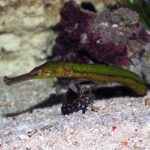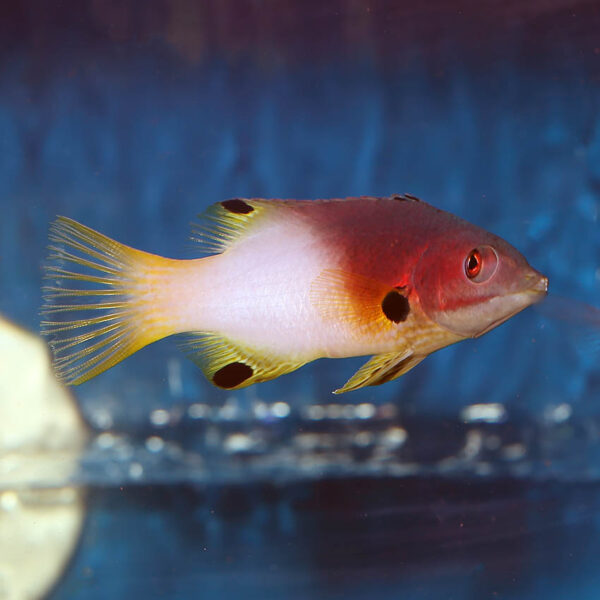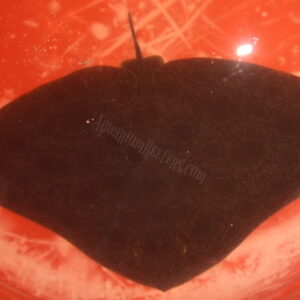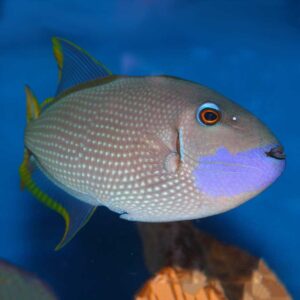Description
The Axilspot Hogfish (Bodianus axillaris) can grow up to a maximum size of approximately 8 inches (20 cm). It has an elongated body with a sloping forehead and a pointed snout. The head is primarily reddish-orange, with a prominent dark spot on the upper part of the gill cover. The fins are generally yellowish, and the caudal fin has a lyre-like shape.
Taxonomy:
The Axilspot Hogfish belongs to the genus Bodianus in the family Labridae, which includes other wrasses. It is closely related to other hogfish species such as the Spanish Hog (Bodianus rufus) and the Lyretail Hog (Bodianus anthioides).
Natural Habitat:
In its natural habitat, the Axilspot Hogfish inhabits coral reefs and rocky areas with ample hiding places. It is commonly found in the Indo-Pacific region, including the Red Sea, the Maldives, and the Great Barrier Reef. These areas provide a diverse range of coral formations and reef structures that offer shelter and feeding opportunities for the species.
Keeping the Axilspot Hogfish Healthy:
The Axilspot Hog requires a moderate level of care and is suitable for intermediate-level aquarium keepers. It thrives in a well-maintained aquarium with stable water parameters. Regular monitoring of water quality, including temperature, salinity, and nutrient levels, is essential to ensure the health and well-being of this species. The aquarium should provide ample hiding places and open swimming areas.
Special Requirements and Feeding:
The Axilspot Hogfish is a carnivorous species and requires a varied diet consisting of high-quality marine-based foods. This can include small crustaceans, Mysis shrimp, brine shrimp, and chopped meaty foods. Offering a mix of frozen and live foods can help provide a balanced diet and stimulate natural feeding behaviours.
How Many Should I Keep?
The Axilspot Hogfish is generally best kept singly or in mated pairs to minimize aggression. They may exhibit territorial behaviour, particularly towards other fish of similar size and appearance. Providing adequate space and hiding places within the aquarium is crucial to reduce stress and promote harmonious coexistence.
Lighting Preference:
The Axilspot Hogfish does not have specific lighting preferences. However, providing moderate to high lighting levels can help enhance the vibrant colouration and natural behaviours of the fish.
Suitable Tank Mates:
When selecting tank mates for the Axilspot Hog, it is important to consider their compatibility. Avoid keeping them with aggressive or territorial fish that may provoke conflict. Peaceful, similarly sized species that inhabit different areas of the aquarium can make suitable tank mates. Caution should be exercised when introducing new fish to ensure they are not threatened or harassed.
Breeding Bodianus axillaris:
- Set up:
Breeding the Axilspot Hogfish in captivity requires a well-maintained aquarium with suitable conditions. Provide ample hiding places using live rock or artificial structures to mimic the natural reef environment. The tank should have stable water parameters, including a temperature of around 77-82°F (25-28°C), a pH range of 8.1-8.4, and a specific gravity of 1.023-1.025.
- Courtship/Spawning:
Courtship and spawning behaviours of the Axilspot Hog are not well-documented. In the wild, these fish are known to form distinct pairs. Courtship likely involves displays of colouration and fin movements by the male to attract and court the females.
- Rearing:
After successful spawning, the female Axilspot Hogfish releases the eggs into the water column, where they are fertilized by the male. The eggs are then carried by the water currents until they hatch into larvae. Rearing the larvae in a separate rearing tank with appropriate water conditions, temperature, and feeding protocols is crucial for their survival. The larvae require small live foods such as rotifers and copepods until they can transition to larger food sources.
Sexual Dimorphism:
The Axilspot Hogfish exhibits sexual dimorphism, where males and females have different physical characteristics. The males tend to be larger and more brightly coloured than females. They may also develop elongated fin extensions and more pronounced patterns on their bodies.
Distribution:
The Axilspot Hogfish, Bodianus axillaris, is naturally found in the Indo-Pacific region, including areas such as the Red Sea, the Maldives, and the Great Barrier Reef. While there may be captive-bred and line-bred strains available in the aquarium trade, the original wild fish come from these regions.
Summary:
The Axilspot Hogfish, Bodianus axillaris, is a captivating and beautiful species that adds vibrancy to marine aquariums. With its maximum size of approximately 8 inches (20 cm), it requires a well-maintained tank with stable water parameters. While their reproductive behaviour in the wild is not extensively studied, breeding them in captivity requires appropriate tank setup, courtship behaviours, and rearing techniques. The species exhibits sexual dimorphism, with males displaying more elaborate colours and patterns. The Axilspot Hog is naturally distributed in the Indo-Pacific region, and while captive-bred strains may be available, the original fish are found in areas such as the Red Sea and the Great Barrier Reef.
The Fish pictured here are representative only and the livestock you receive may vary in pattern, coloration, and shape.









Reviews
There are no reviews yet.